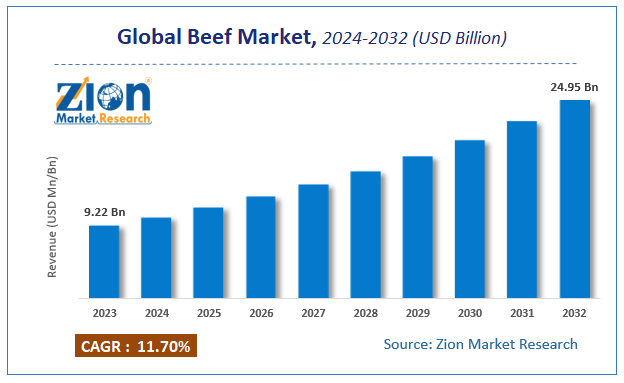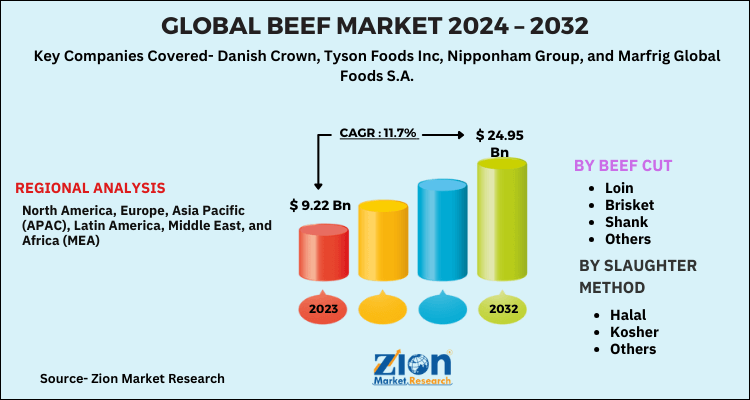Global Beef Market Size, Share, Trends, Growth and Forecast 2032

Global Beef Market - By Beef Cut (Shank, Brisket, Loin, and Others), By Slaughter Method (Halal, Kosher, and Others), and By Region - Industry Perspective, Comprehensive Analysis, and Forecast, 2024 - 2032-
| Market Size in 2023 | Market Forecast in 2032 | CAGR (in %) | Base Year |
|---|---|---|---|
| USD 9.22 Billion | USD 24.95 Billion | 11.7% | 2023 |
Beef Market Insights
According to Zion Market Research, the global Beef Market was worth USD 9.22 Billion in 2023. The market is forecast to reach USD 24.95 Billion by 2032, growing at a compound annual growth rate (CAGR) of 11.7% during the forecast period 2024-2032.
The report offers a comprehensive analysis of the market, highlighting the factors that will determine growth, potential challenges, and opportunities that could emerge in the Beef industry over the next decade.
Introduction
Global consumers' food preferences have experienced a number of significant shifts as a result of growing global. Consumers are consuming more protein, which is driving up demand for beef. In addition to saving a ton of time and effort in the kitchen, meat and its products are jam-packed with a variety of vital components and nutrients. As a result, producers are mainly concerned with the quality of the flesh and its by-products.
One of the main elements influencing the market is the growing demand for animal-sourced protein and rising health consciousness among the general population. Consumer preferences are quickly changing in favor of food items with high protein content and minimal fat and calorie content due to changing dietary habits.
Additionally, beef's growing use in the food sector is helping the market to expand. To offer customers genuine and multi-cuisine dishes, many cafes and eateries serve beef-based burgers, hotdogs, sausages, filets, steaks, and stews.
The rise in disposable income of middle-class consumers in developing nations in Latin America and the Asia-Pacific, as well as the significant demand for convenience foods among the working population and the younger generations who enjoy cooking at home, are some of the main factors driving the demand for meat. The busy daily schedules of consumers have broadened the market potential for ready-to-eat meat products globally over the past few years.
The escalating demand for beef as a major source of protein is escalating globally, although in most countries beef contributes considerably lesser than 50% of overall meat intake. Furthermore, beef enriches the eating experience of consumers in developed countries as well as in emerging economies. Natural resources encompasses utilization of land for cattle, access to livestock feed, and the strength of the economy of the nation are key determinants of the beef sustainability. Moreover, the sustainability of production of beef has myriad interpretations across a spectrum of topographical and socio-economic regions across the globe based on the beliefs, rules, religious customs, traditions, and livelihoods of a particular region.
As per NCBI, EU was one of the largest beef producers in 2018 across globe with comparatively low GHG emission. However, varied differences in climatic conditions, availability of grass, and farming techniques has resulted in income variations of beef manufacturer as well as different output in these regions. Furthermore, Europe has a variety of beef farming structures as well as supply chains with the beef producing systems fulfilling the beef requirements of the sub-continent based on the climate, location, per capita income, and social requirements of each area or country of the sub-continent.
Additionally, according to NCBI records, Australia was one of the largest exporter of the beef in 2018 with consumer driven modelling method contributing massively towards the growth of the beef industry in the region. Apart from this, the tool proved effective in assessing beef palatability not only in Australia but also across myriad countries of the globe with European countries being the most prominent to use the technique.
Market Growth Dynamics
Growing demand for protein-rich diet along with the contribution of beef production towards food security & socio-economic well-being of rural communities in European countries will steer the market growth. In addition to this, gastronomic pleasure of beef intake by urban & rural customers in European continent will drive the market growth trends. Furthermore, beef also provides vital nutrients to the consumers and this will further embellish the industry growth over the forecast timeline.
Additionally, surging urbanization and rise in the population across the globe along with requirement for feeding the population are some of the key aspects likely to steer the business growth over the forecast period. Rapid spread of diseases in the pork and poultry have led to growing popularity of beef among the customers. Apart from this, escalating demand for kosher as well as halal beef is predicted to propel the industry growth in the foreseeable future.
Beef Market: Report Scope
| Report Attributes | Report Details |
|---|---|
| Report Name | Beef Market |
| Market Size in 2023 | USD 9.22 Billion |
| Market Forecast in 2032 | USD 24.95 Billion |
| Growth Rate | CAGR of 11.7% |
| Number of Pages | 110 |
| Key Companies Covered | Danish Crown, Tyson Foods Inc, Nipponham Group, and Marfrig Global Foods S.A |
| Segments Covered | By Beef Cut, By Slaughter Method And By Region |
| Regions Covered | North America, Europe, Asia Pacific (APAC), Latin America, Middle East, and Africa (MEA) |
| Base Year | 2023 |
| Historical Year | 2018 to 2022 |
| Forecast Year | 2024 - 2032 |
| Customization Scope | Avail customized purchase options to meet your exact research needs. Request For Customization |
Asia Pacific Market To Acquire Numero Uno Position Across Global Market By 2032
The regional market growth during the forecast period is attributed to countries like China, Thailand, Australia, and Japan contributing towards major beef production. Apart from this, rapid changing beef intake dynamics in Asia along with upsurge in the economic growth witnessed in Asian countries will steer the market expansion in the region. Also, there is an exponential inflation in the livestock population in the emerging countries of the region including south-east nations. Massive use of concentrate animal feeds for enhancing growth in animals & meat quality will further carve a profitable growth trajectory for the market in the region.
On other hand, China ranked third in the beef production across the globe in 2018. Beef is a main component of livestock rearing & meat production in the country. Moreover, a prominent increase in beef intake and surge in gross domestic beef production due to swift economic growth in China will further drive the market trends in Asia Pacific zone.
Key market players profiled in the report include are-
- Danish Crown
- Tyson Foods Inc
- Nipponham Group
- Marfrig Global Foods S.A.
The global beef market is segmented as follows:
By beef cut
- Loin
- Brisket
- Shank
- Others
By slaughter method
- Halal
- Kosher
- Others
By Region
- North America
- The U.S.
- Canada
- Europe
- France
- The UK
- Spain
- Germany
- Italy
- Rest of Europe
- Asia Pacific
- China
- Japan
- India
- South Korea
- Southeast Asia
- Rest of Asia Pacific
- Latin America
- Brazil
- Mexico
- Rest of Latin America
- Middle East & Africa
- GCC
- South Africa
- Rest of Middle East & Africa
Table Of Content
Methodology
FrequentlyAsked Questions
The key growth factors will influence the market growth include beef intake due to the product being major source of protein and escalating need for feeding rapidly rising population across the globe.
Beef Market was worth USD 9.22 Billion in 2023. The market is forecast to reach USD 24.95 Billion by 2032, growing at a compound annual growth rate (CAGR) of 11.7% during the forecast period 2024-2032.
Asia Pacific region will contribute remarkably towards the global market share over the estimated timeline.
The key market participants include Danish Crown, Tyson Foods Inc., Nipponham Group, and Marfrig Global Foods S.A.
RelatedNews
HappyClients
Zion Market Research
Tel: +1 (302) 444-0166
USA/Canada Toll Free No.+1 (855) 465-4651
3rd Floor,
Mrunal Paradise, Opp Maharaja Hotel,
Pimple Gurav, Pune 411061,
Maharashtra, India
Phone No +91 7768 006 007, +91 7768 006 008
US OFFICE NO +1 (302) 444-0166
US/CAN TOLL FREE +1 (855) 465-4651
Email: sales@zionmarketresearch.com
We have secured system to process your transaction.
Our support available to help you 24 hours a day, five days a week.
Monday - Friday: 9AM - 6PM
Saturday - Sunday: Closed







